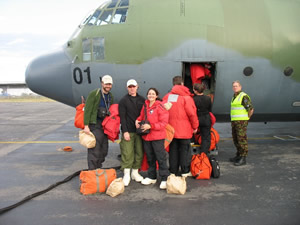| Weather is McMurdo’s queen diva – unpredictable, perverse, subject to frequent changes in mood, outbursts of extreme behavior, and stingingly cold moments of intense beauty. The station and flights to and from it revolve around her demands. When you go to the ice, you’re never quite sure how the drama will unfold. On Friday Ben, Kirk, Ray, and I showed up at the airport at 6 AM, put on all our ECW gear, boarded the plane, and took off as planned. The Royal New Zealand Air Force was flying us down, and we headed full throttle towards the Antarctic Circle, The Point of No Return, and what we feared was Antarctica flight scenario 3.
Like the equator and the Tropics of Cancer and Capricorn, the Antarctic Circle is a line of latitude encircling the globe. It is located at about 66.5° south. Together with the Arctic Circle at 66.5° north and the two tropics, the Antarctic Circle defines the earth’s broad climatic categories. Climate is average weather over long time periods. The area between the two tropics is referred to as the low latitudes and the climate there is considered tropical with high rainfall and consistently high temperatures. The areas between the tropics and the Arctic or Antarctic Circles are know as the middle latitudes and are characterized by four distinct seasons. The areas between the Arctic or Antarctic Circles and the poles are called the high latitudes and experience extremely long and cold winters. |

Getting on the Royal New Zealand Air Force plane taking us to the ice
|
| During the solstice on June 20 th or 21 st, the Tropic of Cancer represents the northerly most latitude at which the sun can shine directly overhead, all regions north of the Arctic Circle experience 24 hours of daylight, and all regions south of the Antarctic Circle have 24 hours of darkness. It is the start of the northern hemisphere’s summer and the southern hemisphere’s winter. During the solstice on December 21 st or 22 nd, the Tropic of Capricorn is the southerly most latitude at which the sun can shine directly overhead, all regions north of the Arctic Circle experience 24 hours of darkness, and all regions south of the Antarctic Circle have 24 hours of sunlight. It is the start of the northern hemisphere’s winter and the southern hemisphere’s summer. Although the sun shines all day during a polar summer, the temperatures remain cooler than those of a tropical or temperature summer because sun angles are lower. |

